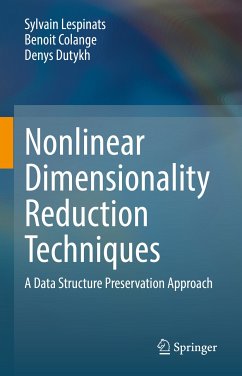Nonlinear Dimensionality Reduction Techniques (eBook, PDF)
A Data Structure Preservation Approach


Alle Infos zum eBook verschenken

Nonlinear Dimensionality Reduction Techniques (eBook, PDF)
A Data Structure Preservation Approach
- Format: PDF
- Merkliste
- Auf die Merkliste
- Bewerten Bewerten
- Teilen
- Produkt teilen
- Produkterinnerung
- Produkterinnerung

Hier können Sie sich einloggen

Bitte loggen Sie sich zunächst in Ihr Kundenkonto ein oder registrieren Sie sich bei bücher.de, um das eBook-Abo tolino select nutzen zu können.
This book proposes tools for analysis of multidimensional and metric data, by establishing a state-of-the-art of the existing solutions and developing new ones. It mainly focuses on visual exploration of these data by a human analyst, relying on a 2D or 3D scatter plot display obtained through Dimensionality Reduction (DR). Performing diagnosis of an energy system requires identifying relations between observed monitoring variables and the associated internal state of the system. Dimensionality reduction, which allows to represent visually a multidimensional dataset, constitutes a promising…mehr
- Geräte: PC
- ohne Kopierschutz
- eBook Hilfe
- Größe: 17.07MB
![Dimensionality Reduction in Data Science (eBook, PDF) Dimensionality Reduction in Data Science (eBook, PDF)]() Dimensionality Reduction in Data Science (eBook, PDF)38,95 €
Dimensionality Reduction in Data Science (eBook, PDF)38,95 €![Geometric Structure of High-Dimensional Data and Dimensionality Reduction (eBook, PDF) Geometric Structure of High-Dimensional Data and Dimensionality Reduction (eBook, PDF)]() Jianzhong WangGeometric Structure of High-Dimensional Data and Dimensionality Reduction (eBook, PDF)81,95 €
Jianzhong WangGeometric Structure of High-Dimensional Data and Dimensionality Reduction (eBook, PDF)81,95 €![Elements of Dimensionality Reduction and Manifold Learning (eBook, PDF) Elements of Dimensionality Reduction and Manifold Learning (eBook, PDF)]() Benyamin GhojoghElements of Dimensionality Reduction and Manifold Learning (eBook, PDF)53,95 €
Benyamin GhojoghElements of Dimensionality Reduction and Manifold Learning (eBook, PDF)53,95 €![Multi-Label Dimensionality Reduction (eBook, PDF) Multi-Label Dimensionality Reduction (eBook, PDF)]() Liang SunMulti-Label Dimensionality Reduction (eBook, PDF)54,95 €
Liang SunMulti-Label Dimensionality Reduction (eBook, PDF)54,95 €![Unsupervised Learning Approaches for Dimensionality Reduction and Data Visualization (eBook, PDF) Unsupervised Learning Approaches for Dimensionality Reduction and Data Visualization (eBook, PDF)]() B. K. TripathyUnsupervised Learning Approaches for Dimensionality Reduction and Data Visualization (eBook, PDF)65,95 €
B. K. TripathyUnsupervised Learning Approaches for Dimensionality Reduction and Data Visualization (eBook, PDF)65,95 €![Predictive Intelligence in Medicine (eBook, PDF) Predictive Intelligence in Medicine (eBook, PDF)]() Predictive Intelligence in Medicine (eBook, PDF)40,95 €
Predictive Intelligence in Medicine (eBook, PDF)40,95 €![Open Problems in Spectral Dimensionality Reduction (eBook, PDF) Open Problems in Spectral Dimensionality Reduction (eBook, PDF)]() Harry StrangeOpen Problems in Spectral Dimensionality Reduction (eBook, PDF)40,95 €
Harry StrangeOpen Problems in Spectral Dimensionality Reduction (eBook, PDF)40,95 €- -44%11
-
-
Classical dimensionality reduction techniques such as tSNE and Isomap are presented, as well as the new unsupervised technique ASKI and the supervised methods ClassNeRV and ClassJSE. A new approach, MING for local map quality evaluation, is also introduced. These methods are then applied to the representation of expert-designed fault indicators for smart-buildings, I-V curves for photovoltaic systems and acoustic signals for Li-ion batteries.
Dieser Download kann aus rechtlichen Gründen nur mit Rechnungsadresse in A, B, BG, CY, CZ, D, DK, EW, E, FIN, F, GR, HR, H, IRL, I, LT, L, LR, M, NL, PL, P, R, S, SLO, SK ausgeliefert werden.
- Produktdetails
- Verlag: Springer Nature Switzerland
- Seitenzahl: 247
- Erscheinungstermin: 2. Dezember 2021
- Englisch
- ISBN-13: 9783030810269
- Artikelnr.: 63076388
- Verlag: Springer Nature Switzerland
- Seitenzahl: 247
- Erscheinungstermin: 2. Dezember 2021
- Englisch
- ISBN-13: 9783030810269
- Artikelnr.: 63076388
- Herstellerkennzeichnung Die Herstellerinformationen sind derzeit nicht verfügbar.







